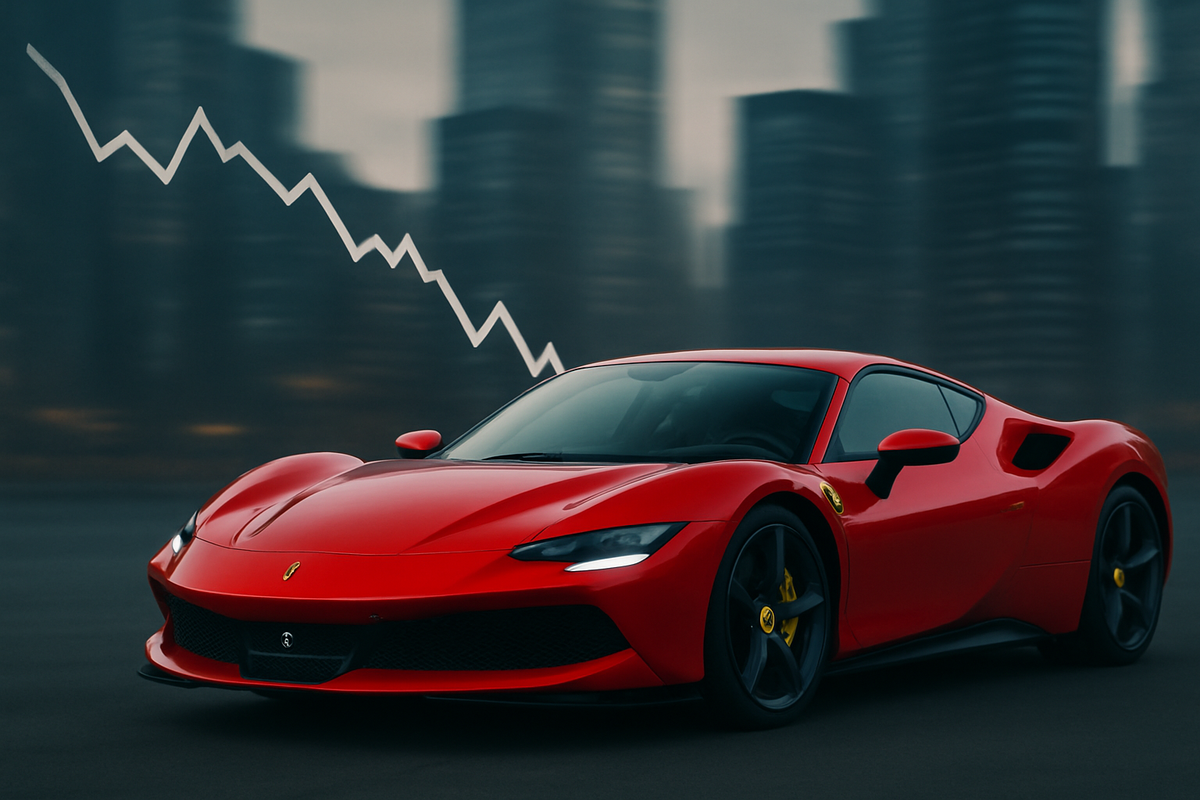
Maranello, Italy – October 9, 2025 – The venerable Italian luxury sports car manufacturer, Ferrari (NYSE: RACE), experienced a tumultuous day on the stock market today, with its shares plummeting over 14%. This significant decline marks the steepest single-day drop for the iconic brand since its 2016 listing and sent immediate ripples through the global financial markets. The sharp sell-off was a direct and pronounced reaction to the company's Capital Markets Day presentation, during which Ferrari unveiled its updated 2030 Strategic Plan and revised financial forecasts. Investors reacted with palpable disappointment to what they perceived as conservative long-term financial targets and a notably scaled-back commitment to electric vehicles, overshadowing any positive adjustments to near-term guidance.
The market's immediate and forceful response underscores a growing investor expectation for aggressive electrification strategies and robust long-term growth in the automotive sector, even for ultra-luxury brands. Ferrari's strategic recalibration, while potentially pragmatic, appears to have clashed with these elevated expectations, leading to a substantial re-evaluation of its future trajectory by market participants.
Unpacking the Rationale Behind Ferrari's Steep Decline
The primary catalysts for Ferrari's substantial stock drop on October 9, 2025, stemmed directly from key announcements made during its Capital Markets Day. Foremost among these were the company's long-term financial projections for 2030, which fell significantly short of analyst consensus. Ferrari targeted revenues of €9 billion and earnings before interest and tax (EBIT) of at least €2.75 billion (or adjusted EBITDA of at least €3.6 billion) by 2030. However, market analysts had anticipated more ambitious figures, with some modeling revenues closer to €9.8 billion and EBIT around €3.25 billion. This more conservative outlook implied a compound annual growth rate (CAGR) for EBITDA of approximately 6%, notably lower than the 10% many analysts had previously modeled, signaling a potential deceleration in the company's long-term earnings trajectory.
A second, equally impactful factor was Ferrari's revised electrification strategy. The company announced a significant reduction in its fully electric vehicle (EV) ambitions, now expecting EVs to constitute only 20% of its product lineup by 2030. This marks a substantial decrease from its previous target of 40%. The updated plan outlines a 2030 portfolio comprising 40% internal combustion engine (ICE) vehicles, 40% hybrids, and 20% electric models. While Ferrari did confirm the upcoming launch of its first all-electric vehicle, dubbed "Elettrica," with deliveries slated for late 2026, the dampened long-term EV forecast disappointed investors who were likely anticipating a more aggressive and forward-looking transition into the electric market, aligning with broader industry trends and environmental mandates.
The overall sentiment conveyed during the Capital Markets Day presentation also contributed to investor unease. Beyond the specific 2030 targets, the perceived "downshift in EBIT growth from prior history" indicated a more cautious growth trajectory than previously anticipated. Despite a slight upward revision in its near-term 2025 guidance for profit and revenue, these positive adjustments were ultimately overshadowed by the underwhelming long-term outlook and the perceived hesitancy in embracing full electrification, culminating in the substantial stock decline. Key players involved in this event include Ferrari's executive management, particularly CEO Benedetto Vigna, who presented the strategic plan, as well as institutional investors and market analysts whose reactions shaped the stock's immediate performance.
Market Shifts: Winners and Losers in the Wake of Ferrari's Strategic Pivot
Ferrari's (NYSE: RACE) significant stock decline and revised strategic outlook have immediate implications for the company itself, while also sending ripples across the luxury automotive sector and the broader electric vehicle market. For Ferrari, the immediate impact is a dent in investor confidence and a re-evaluation of its long-term growth potential. The market's reaction suggests that investors were looking for a more aggressive stance on electrification and higher growth targets, and the company's conservative approach has been met with skepticism. Despite the stock drop, Ferrari maintains strong underlying financial fundamentals, including robust revenue and earnings growth, high profit margins, and significant pricing power due to its exclusive brand and long waiting lists. The company's plan to introduce an average of four new models annually through 2030, including the "Elettrica" in late 2026, indicates a continued focus on product innovation, albeit with a moderated electrification pace. The challenge for Ferrari will be to convince investors that its pragmatic approach to electrification will ultimately preserve its brand identity and profitability in a rapidly changing industry.
The ramifications extend to other luxury car manufacturers. Ferrari's decision to slow its EV transition, favoring a "hybrid-first" approach, aligns with a broader trend among ultra-luxury automakers such as Lamborghini (part of Volkswagen AG (FWB: VOW3)), McLaren, and Aston Martin (LSE: AML). These brands face similar challenges in electrifying high-performance, exclusive vehicles without compromising their core DNA. Ferrari's move could reinforce caution within this segment, reducing pressure on competitors to commit to aggressive all-electric timelines. Instead, they may continue to focus on hybrid technologies as a bridge, allowing them to manage high development costs, address customer preferences for traditional powertrains, and ensure electric models genuinely uphold their brand's performance heritage. This could lead to a sustained emphasis on customization and exclusivity, which are key revenue drivers for these brands, irrespective of powertrain type.
Conversely, pure-play electric vehicle (EV) companies might view Ferrari's recalibration with a mix of validation and opportunity. Ferrari's acknowledgment of uncertain demand for high-end electric supercars, coupled with the high costs and technical complexities of maintaining performance, validates some of the inherent difficulties in electrifying the extreme high-end segment. This could be seen as an opportunity for EV specialists like Tesla (NASDAQ: TSLA), Lucid Group (NASDAQ: LCID), and Rivian Automotive (NASDAQ: RIVN). These companies, built on native EV platforms, specialize in electric propulsion and could potentially capture market share in the luxury performance space if they can overcome cost and production challenges. Furthermore, Ferrari's caution might prompt traditional luxury brands to seek partnerships with EV specialists for expertise. While the broader EV market continues to grow rapidly, Ferrari's strategic shift suggests that the ultra-luxury segment may exhibit differentiated adoption patterns, driven by factors beyond those influencing mass-market or broader premium EVs.
Broader Horizons: Ferrari's Strategy Amidst Industry Evolution
Ferrari's (NYSE: RACE) recent strategic pivot is not an isolated event but rather a significant indicator of evolving dynamics within the ultra-luxury and high-performance automotive sectors. This move reflects a broader industry trend where the rapid, all-encompassing electrification seen in the mass market is being approached with greater caution and nuance in the high-end segment. While the overall luxury EV market is experiencing growth, particularly in segments like SUVs, there's a recognized slowdown in demand for high-end electric sports cars. This suggests a bifurcation in consumer preference, where practicality and range are prioritized in some luxury EV segments, while the traditional "driving experience" — deeply tied to engine sound and feel — remains paramount in high-performance sports cars.
This nuanced approach to electrification is being adopted by many luxury performance brands, including competitors like Lamborghini (part of Volkswagen AG (FWB: VOW3)), McLaren, and Aston Martin (LSE: AML), who are also pursuing a "hybrid-first" strategy. This allows them to meet emissions regulations while retaining the emotional appeal and performance characteristics associated with their internal combustion engine (ICE) heritage. Porsche (part of Volkswagen AG (FWB: VOW3)), another key competitor, has similarly delayed the launch of several all-electric models, prioritizing ICE and hybrid versions, citing a slowdown in high-end EV demand and rising economic pressures. This convergence of strategy among top-tier luxury performance brands indicates a shared perception of market realities and challenges in electrifying their unique offerings.
The regulatory landscape is also a significant factor. Ferrari's mention of regulatory uncertainty around synthetic and carbon-neutral fuels aligns with broader industry lobbying efforts, particularly from European automakers. Organizations like the European Automobile Manufacturers' Association (ACEA) are advocating for a "reality check" on stringent EU legislation, such as the 2035 ban on combustion engine sales. They propose that biofuels and synthetic e-fuels be counted as zero-emissions and seek a relaxation of hybrid regulations. If more high-profile luxury brands publicly temper their EV ambitions, it could intensify pressure on policymakers to introduce more flexible pathways to emissions reduction, potentially including greater allowances for advanced ICE and hybrid technologies running on sustainable fuels, though environmental groups warn this could undermine climate goals.
Historically, the automotive industry has witnessed numerous adaptations to technological shifts and economic pressures. Luxury car manufacturers have consistently integrated new technologies to redefine luxury, from early engineering advancements to modern hybrid powertrains, as seen with Ferrari's own LaFerrari supercar in 2013. The current shift away from solely ICE powertrains represents a fundamental challenge to the long-held paradigm where the engine was the primary differentiator for luxury brands. Brands that successfully navigate this transformation, by finding new ways to define and deliver luxury and performance, will thrive, while those unable to adapt risk irrelevance, echoing the fates of companies like Blackberry or Kodak in other industries.
The Road Ahead: Navigating Opportunities and Challenges
Ferrari's (NYSE: RACE) recently unveiled 2030 Strategic Plan sets a pragmatic yet ambitious course for the iconic luxury automaker, aiming for approximately €9.0 billion in net revenue by 2030. This growth is projected to be driven by high-value sports cars, extensive customization, and other car-related activities, supported by a robust order book. While the immediate market reaction saw Ferrari's stock plummet over 14% due to what investors perceived as conservative 2030 financial targets and a scaled-back electric vehicle (EV) ambition, the company's strategy outlines a calculated approach to navigating the evolving luxury automotive landscape.
In the short term (1-3 years), Ferrari has demonstrated resilience by raising its 2025 guidance, projecting profit of at least €8.80 per share on €7.1 billion in revenue, surpassing earlier forecasts. Despite the initial market disappointment, some analysts view the stock dip as a potential buying opportunity for a "highly predictable luxury brand," highlighting Ferrari's exclusivity, high personalization, and strong customer loyalty. The focus on higher-margin limited-edition models and bespoke customization is expected to be a primary driver for short-term profit growth, prioritizing exclusivity over sheer sales volume.
Looking further ahead (5-10+ years), Ferrari's long-term strategy reveals a balanced powertrain approach. By 2030, its product lineup is projected to consist of 40% internal combustion engine (ICE) vehicles, 40% hybrids, and 20% fully electric vehicles. This "technology-neutral" stance aims to manage the industry's technological shift while meticulously preserving the brand's unique driving experience and identity. The first fully electric Ferrari, the "Elettrica," is slated for deliveries in late 2026, with Ferrari committed to developing most critical EV components in-house. This ensures that its electric models deliver the expected performance and emotional connection synonymous with the brand. The company's expansion of "Tailor Made" personalization centers globally and new flagship stores further aims to broaden client engagement and reinforce its luxury lifestyle brand without diluting exclusivity.
Key strategic pivots include the recalibrated electrification pace, a clear emphasis on exclusivity over volume, and significant investment in in-house EV component development. Opportunities for Ferrari abound in the growing global luxury car market, projected to reach over $1 trillion by 2030, driven by increasing wealth and demand for premium experiences. The surging popularity of personalization and the growth in emerging markets like China, India, and the Middle East also present substantial avenues for expansion. Furthermore, Ferrari's extensive experience with hybrid technology positions it to leverage this segment effectively as a bridge to a more electric future.
However, significant challenges remain. Managing investor expectations regarding the pace of EV adoption and long-term financial growth will be crucial. The "dilemma" of weak demand for high-end luxury EVs, coupled with the imperative to maintain brand identity and the distinctive Ferrari driving experience during electrification, poses a complex balancing act. Intensifying competition from both traditional rivals and innovative EV players, along with high development costs and evolving regulatory pressures, will also demand strategic agility. Global economic volatility remains a perennial concern for the luxury market.
Comprehensive Wrap-Up: Assessing Ferrari's Future Trajectory
Ferrari's (NYSE: RACE) recent stock plunge, following its Capital Markets Day, serves as a potent reminder of the delicate balance between investor expectations and strategic pragmatism in a rapidly evolving automotive landscape. The key takeaways from this event are clear: Ferrari's more conservative 2030 financial targets and significantly scaled-back EV ambitions, particularly the reduction from 40% to 20% fully electric vehicles by 2030, were the primary drivers of the market's negative reaction. While the company did unveil its first EV, the "Elettrica," slated for late 2026 deliveries, the overall message was one of cautious evolution rather than revolutionary acceleration into the electric era.
From a market assessment perspective, the initial sharp sell-off indicates investor apprehension regarding Ferrari's long-term competitive positioning and its adaptation to the broader industry shift towards electrification. However, it's worth noting that despite the immediate dip, some analysts maintain a view that Ferrari might be "underpromising to then overdeliver," and the stock may still be considered "modestly undervalued" by some, given its unique brand equity and robust financial fundamentals. The company's underlying financial health, characterized by strong profitability metrics and a sound financial status, remains a significant strength.
The lasting impact of this event could be a re-evaluation of how investors perceive luxury automakers' transition to electrification. Ferrari's strategy, which prioritizes exclusivity, high-margin limited-edition models, and extensive customization, while adopting a more measured approach to EVs, might set a precedent for other ultra-luxury brands facing similar dilemmas. This could lead to ongoing scrutiny of its electrification strategy compared to other luxury automakers, but also potentially validate a "hybrid-first" approach for the high-performance segment.
Moving forward, investors should closely monitor several key areas. The successful execution and market acceptance of the "Elettrica" launch in late 2026 will be critical. The broader trends in the luxury EV market, particularly demand for high-end electric sports cars, will also be a significant indicator. Furthermore, investors should carefully track Ferrari's financial performance against its revised 2030 targets and assess the continued demand for its high-margin offerings. Finally, evolving global economic conditions and regulatory landscapes concerning automotive emissions will remain crucial external factors influencing Ferrari's trajectory. The planned €7 billion in shareholder returns through dividends and share buybacks also signals management's confidence and commitment to shareholder value, which will be closely watched.
This content is intended for informational purposes only and is not financial advice






